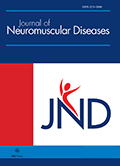Authors: Middelink, Marloes | Voermans, Nicol C. | van Engelen, Baziel G.M. | Janssen, Mirian C.H. | Groothuis, Jan T. | Knuijt, Simone | Zweers-van Essen, Heidi
Article Type:
Systematic Review
Abstract:
Background: Eating an adequate diet and maintaining a healthy body weight can be challenging for patients with muscular disorders (MD). Starting tube feeding can have a positive impact on nutritional status, functioning and quality of life. Guidelines on when to start tube feeding in adults with MD are lacking. Objective: We aim to review the scientific literature on indications to start tube feeding in adults with facioscapulohumeral dystrophy (FSHD), inclusion body myositis (IBM), muscular dystrophy type 1 (DM1), oculopharyngeal muscular dystrophy (OPMD) and congenital myopathies. Methods: This scoping review was conducted according to the Preferred Reporting
…Items for Systematic Reviews and Meta-Analyses extension for scoping reviews (PRISMA-ScR) guidelines. Relevant studies were identified in Pubmed, Embase and Cinahl (April 2022). The medical subject headings (MeSH) and text words used were related to FSHD, IBM, DM1, OPMD or congenital myopathies and dysphagia, enteral nutrition or malnutrition. Results: Of 1046 unique articles, 9 case reports and 2 retrospective case series were included. Indications to start tube feeding were dysphagia, malnutrition/weight loss and respiratory infections (due to aspiration). Percutaneous endoscopic gastrostomy (PEG) tubes were used most often and complications were respiratory failure, problems with the tube itself, accidental tube removal, cutaneous symptoms, digestive symptoms, and peritonitis. Conclusion: Data on tube feeding in MD is scarce. Indications to start tube feeding were similar across the various MD. We call for more research in this field and suggest to include screening for dysphagia, aspiration and malnutrition in for the treatment of various MD.
Show more
Keywords: Enteral nutrition, dysphagia, pneumonia, aspiration, malnutrition, weight loss, muscular dystrophies, myositis, inclusion body, myopathies, structural, congenital
DOI: 10.3233/JND-230014
Citation: Journal of Neuromuscular Diseases,
vol. 10, no. 5, pp. 777-785, 2023





